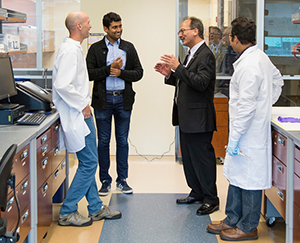Outstanding Investigator
.png) |
|
Scientist Ken Halvorsen demonstrates a strawberry DNA extraction at The RNA Institute's Community Day. |
ALBANY, N.Y. (Nov. 21, 2017) – Ken Halvorsen has spent more than a decade developing novel technologies to investigate biology at the nanoscale level. A nearly $2 million research grant from The National Institutes of Health (NIH) will ensure his lab continues making advancements.
Halvorsen, senior research scientist with The RNA Institute at UAlbany, has received an Outstanding Investigator Award from NIH. It is worth $1.9 million and will be used over the next five years to support his lab’s research.
Unlike typical project grants, this funding supports Halvorsen’s entire vision.
“This award is really exciting,” Halvorsen said. “It gives a lot of flexibility to use resources as we see fit rather than being tied to a specific project. Being able to pivot-in response to discoveries is really important in science. In fact, the technologies we’re working on now would not have been invented without having that flexibility.”
The Halvorsen Lab is particularly interested in developing tools and methods for the detection and analysis of RNA – a vital class of molecules that are essential for all known forms of life. RNA-based therapeutics can be used in both clinical diagnosis and possible treatment of some of the most difficult human diseases, ranging from cancer to HIV/AIDS.
Currently, the Havorsen Lab is focused on the developed of two technologies, both of which he co-invented with professor Wesley Wong at Harvard University.
 |
|
President Havidán Rodríguez is introduced by biology professor Prash Rangan to Bijan Dey and Ken Halvorsen of The RNA Institute. (Photo by Carlo de Jesus)
|
One technology, an instrument called the Centrifuge Force Microscope (CFM), will enable high-throughput probing of individual RNA molecules to analyze their structure and function.
The second technology Halvorsen calls ‘DNA nanoswitches’ are small programmable switches that can change their shape to report the presence of a specific target molecule. The lab team is working to adapt nanoswitches to detect various RNA molecules – including those that are found in the Zika virus.
“These are two exciting technology platforms for RNA research. The NIH award for Dr. Halvorsen’s research program is a testament to his innovative ideas. Congratulations to Ken and his team for this new grant,” said Thomas Begley, interim director of The RNA Institute.
“This is just one example of why flexible funding for science research is so important and why Ken’s grant is invaluable to the work he’s doing at the Institute,” added Paul Agris, founding director of The RNA Institute.
Halvorsen said The RNA Institute provides the environment necessary for his unique work. His lab is also collaborating with leading RNA scientists to make sure the technologies developed have practical usages, in their labs and the broader scientific community.
The hope is that the benefits and implications of his lab’s work will be far-reaching on future RNA research.
“Ultimately, my goal is to see these technologies become common tools in the scientific community and to eventually find clinical use in disease diagnostics,” Halvorsen said.
You can learn about The RNA Institute by clicking here.
![]() For more news, subscribe to UAlbany's RSS headline feeds
For more news, subscribe to UAlbany's RSS headline feeds
A comprehensive public research university, the University at Albany-SUNY offers more than 120 undergraduate majors and minors and 125 master's, doctoral and graduate certificate programs. UAlbany is a leader among all New York State colleges and universities in such diverse fields as atmospheric and environmental sciences, business, education, public health,health sciences, criminal justice, emergency preparedness, engineering and applied sciences, informatics, public administration, social welfare and sociology, taught by an extensive roster of faculty experts. It also offers expanded academic and research opportunities for students through an affiliation with Albany Law School. With a curriculum enhanced by 600 study-abroad opportunities, UAlbany launches great careers.


